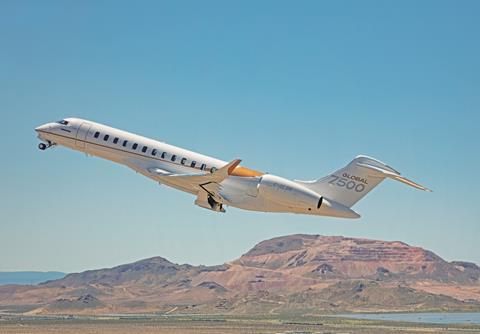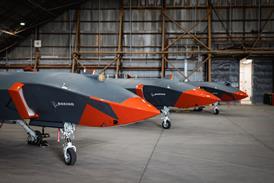Threats by president-elect Donald Trump to slap 25% tariffs on Canadian imports have caught the attention of Canada’s aerospace industry, which depends heavily on sales of aircraft and components to US buyers.
Trump’s threat of a similar 25% tax on imported Mexican products has also raised questions about potential fallout in that country’s aerospace sector, which produces components for major US firms.
“Proposed tariffs that could have a broad impact are clearly a concern for all companies who participate in a global economy and supply chain,” Quebec-headquartered business jet maker Bombardier said on 2 December.

That statement came after Trump on 25 November said one of his “first” executive orders will be to “charge Mexico and Canada a 25% tariff on all products coming into the United States”.
Trump, who is to be sworn in as president on 20 January, said he will impose such tariffs until those countries take steps to reduce the flow of fentanyl and illegal immigrants coming into the USA. Trump, who has also talked of imposing steeper tariffs on China, made the threats on his social media platform Truth Social.
Business aviation analyst Brian Foley says there is “clearly… some concern” about such a tariff impacting Bombardier. He notes that the USA constitutes the world’s largest business jet market and that Bombardier’s stock slumped after Trump’s tariff threat.
“The 25% tariff, if it comes into effect, will… dramatically affect the aerospace [and] aircraft industry because of the supply chains that take parts and components back and forth across the border,” says Gary Hufbauer, fellow at US nonprofit research group Peterson Institute for International Economics.
Whether Trump will make good on his threats remains uncertain, as is how such tariffs might theoretically be structured.
“It is simply too early to speculate on what will be imposed, and we are confident that governments will be able to mitigate this risk through constructive and collaborative discussions that place economic prosperity on both sides of the border above all else,” says Bombardier.
It is possible Canada or Mexico will head off tariffs by making deals with the incoming president. Hufbauer can imagine Canada appeasing Trump by agreeing to deploy several thousand more Canadian Mounties along the US border. “It’s expensive… but not anywhere near the expense that the 25% tariff war would cause,” he says.
Even talk of steep new import duties has raised eyebrows and prompted concern about possible impacts on an industry that significantly depends on the movement of raw materials, parts and finished products across North American borders.
Many US aerospace companies, including the largest players, have in recent decades moved production of some components to lower-cost sites in Mexico. Those parts are then shipped to the USA for assembly into finished products.
Canadian firms also supply parts to major US aerospace manufacturers. And Canada is home to major airframers like Bombardier and De Havilland Canada, which depend significantly on sales to US buyers. Airbus makes A220s in Quebec as well as in Mobile, Alabama. Canadian producers face the risk that tariffs would inflate prices paid by US buyers.
“The imposition of 25% tariffs would have significant repercussions on the entire aerospace ecosystem, both here in Quebec and globally,” says trade group Aero Montreal. “Our industry relies on deeply integrated supply chains that transcend borders. While this threat is concerning, it is also an opportunity to demonstrate the strength of our collaboration with governments and international partners.”
Airbus and De Havilland declined to comment, saying they are monitoring developments. Several other major Canadian aerospace and aviation companies did not respond to requests for comment.
Responding on 29 November to Trump’s tariff threat, Canadian prime minister Justin Trudeau said “there is no question” Trump would move forward with tariffs. He added that Canada must convince Trump that import duties would increase prices both in Canada and the USA.
Trudeau flew to Florida on 29 November to meet Trump at the president-elect’s Mar-a-Lago home. Trump later posted on Truth Social that he and Trudeau had a “very productive meeting”.
Trade experts say tariffs typically apply to the full value of products – as such, a sweeping 25% tariff could mean US buyers pay one-quarter more for aerospace products made in Canada or Mexico – from nuts and bolts to landing gears, aerostructures or entire aircraft.
But Foley views Trump’s tariff bluster as a negotiating tactic. “He’s a smart guy when it comes to negotiating and getting the most leverage,” Foley says. “I think he came out with a big bang with the 25%. For me, that is a starting point.”
Alex Krutz, analyst with Patriot Industrial Partners, would not be surprised if aerospace components fall outside any tariffs Trump imposes on Canada or Mexico. The incoming president has shown interest in targeting products for which US companies relocated high-volume production from the USA to lower-cost sites in those countries, he notes. Such products include automobiles, tractors and other items that are now finished outside the US.
“I don’t think companies that make small parts will be the focus for him and [his] tariffs,” Krutz says.
If Trump moves forward, the aerospace sector, like other industries, will likely start lobbying for tariff exemptions, making the case that their products are made from components sourced from around the globe.
Bombardier notes that the “majority” of materials found on its jets actually originate “from suppliers in the US”. Its Global 7500, for instance, has GE Aerospace engines. Such is the case with other Canadian-made aircraft and many Canadian-built components. GE Aerospace declines to comment.

“On top of this, we directly manufacture a variety of components in multiple states,” Bombardier adds. “These activities, multiplied across our industry, contribute to sustaining tens of thousands of high-value jobs in the US as well as tens of thousands in Canada. All ongoing discussions must focus on preserving them.”
Analysts also suspect new Trump tariffs would prompt Canada and Mexico to respond with their own import taxes on US products.
“Most countries, if you impose a tariff on them, they follow suit,” says Colin Grabow, a trade protectionist expert at think tank Cato Institute.
Were that to happen, Canadian aircraft makers could “get hurt two ways”: being forced to pay Canadian-imposed duties on US-made engines and having their aircraft subject to US import taxes on the other side of the border.
Retaliatory Canadian tariffs could likewise impact US manufacturers like Textron Aviation and Gulfstream, which both produce aircraft powered by Pratt & Whitney Canada (P&WC) engines, Foley notes. P&WC parent RTX declines to comment.
If tariff wars do erupt, expect the aerospace industry’s lawyers to begin poring through obscure provisions of US law that could help ease the sting. One rarely used provision – stemming from America’s early days – allows for a “duty drawback” – a refund of tariffs paid on goods shipped back and forth across borders, says Hufbauer.
“If this comes into effect, people will bother to look at these old statutes and they may try to update them,” Hufbauer says. “It would be worth paying a lot to lobby for the duty drawback.”


























